This article appeared in Spectrum, Deccan Herald’s Tuesday Supplement on January 18, 2011.
In the seemingly arid landscape along the National Highway 4 between Bangalore and Tumkur, there lies a stretch of thick forest and a series of hills that sometimes reminds one of the rich greenery and the slopes of Sahyadris. Moving off the highway near Tumkur towards the temple atop the hill at Devarayanadurga, I was surprised to see the boring and wide open highway make way to a leafy stretch of road with dense pack of trees on both sides. The winding road took me to a small perennial spring—Namada Chilime—in the heart of the forest.
The spring water trickles from a depression on a big rock and flows down to fill a pond just below. Legends attribute the spring’s origin to Lord Rama. Rama needed drops of water to smear ‘nama’ on his forehead and decided to extract it by shooting an arrow into the rock. A spring emerged from the rock and was called Namada Chilume.
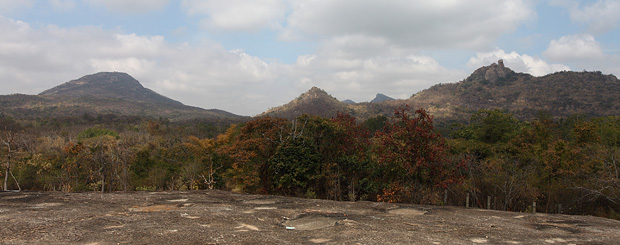
The hills surrounding Namada Chilume
The area around Namada Chilume is a leafy stretch with an enclosure that serves as a deer park. Across the park is a small rocky hillock with a mantapa, which offers views of the forest and the hills around the spring. In the view from mantapa are hills covered with shrub vegetation at their base and tall boulders higher up. In the early days of January when the trees are ready to shed leaves, the landscape occasionally sees a dazzle of yellow and red – as good that the fall colours can get in the tropics. To the east is Devarayanadurga, the tallest hill in the view with a 150-years old temple at the top.
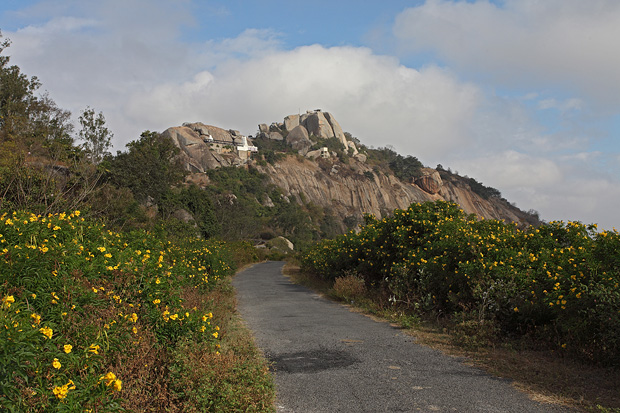
Lakshmi Narasimha Swamy Temple at Devarayanadurga
The foundation of Lakshmi Narasimha Swamy Temple at Devarayanadurga is credited to Hoysala Kings. Its current structure is attributed to the Wodeyar Kings of Mysore. Our road from Namada Chilume to Devarayanadurga meandered through a thick shrub forest as we drove through some steep climbs and switch backs before arriving at Durgadahalli Village just below the temple.
Climbing further to the peak and standing atop Devarayanadurga, nothing blocked my views all the way to the horizon as I looked at the villages on the plains to the east. The northern side of my view had a range of hills that tapered away gently into the plains. Lakes of various sizes glittered in the early morning sun all along the plains, standing out amidst the thin winter fog that hid the details of the landscapes. To the south, a sharp rocky ledge jutted out in the hazy weather as the sun rays filtered through the fog and selectively brightened its half-dome-like peak an an unusually sharp summit pointing towards the sky.
A series of hills decorate the landscape around Devarayanadurga. A thirty-minute drive further north took me to Madhugiri town dominated by a tall rocky hill, whose slopes are criss-crossed by several layers of fort walls.
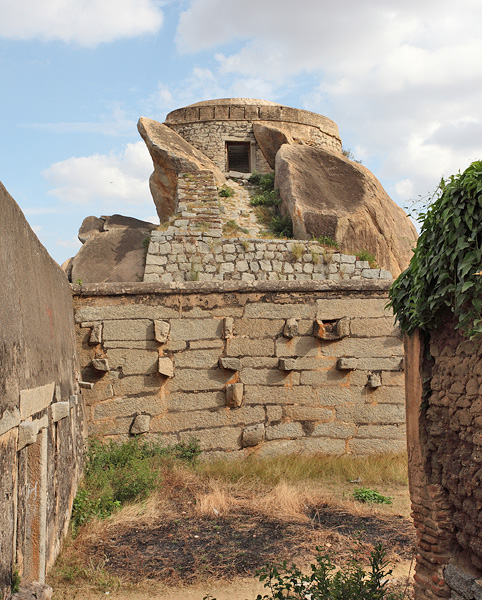
A section of Madhugiri Fort
Madhugiri hill is at an elevation of 3930 feet and is the second largest monolith in Asia. The first work on Madhugiri Fort dates back to Ganga Kings, while the walls remaining today are credited to a local chieftain named Heere Gowda, a feudal of the Vijayanagar Empire. Since the collapse of the empire, the fort was administered by Hyder Ali, Tipu Sultan and later by the Mysore Wodeyars. It is currently managed by Archaeological Survey of India.
Having made an impulsive decision to go up the hill, I climbed slow and easy. I pausing to look at a bastion that offered vista of the town, observed a waterway that filled up a tank in the fort, and stopped to take a good look at the fort walls and store-houses built along the way.
The initial climb is through grassy slopes that soon changes into steep rocky surface with nothing more than small etchings on the rock that served as supporting footsteps. Although the climb can not be called an activity that needed climbing skills, it was steep enough that I was occasionally forced to crawl up through slippery sections.
Standing at the bottom earlier, the climb to the peak appeared like an easy affair that may take no more than thirty minutes at most. But the deceptive fort walls built along the slopes hide the actual peak from the view, making it look like an easy climb. Several times I expected the peak to appear just across the next layer of fort wall, only to realize when I reached there, that it is a long way further.
As I was climbing up the slope, I was also becoming aware of the landscape around the fort, with hills dotting the surroundings and wide sprawl of lakes between them. Assisted by patches of clouds that blocked the sun, light and shadow alternated on the peaks, selectively highlighting some and subduing their neighbours.
It must have taken me more than 2 hours to reach the top and go through last of the fort wall. Located on the top are shelter built of stone that could house a few hundred people, perhaps meant to house the soldiers who guarded the fort. Standing on the top of one of those shelters, I was blessed with the views that made up for the effort of the climb. A series of hills marked the western landscape, dominated by a narrow and rocky peak projecting nearly as high as my platform. A thin road bisected through the hills leading somewhere into their heart and beyond.
The afternoon haze limited my views but the contour of the distant hills looked beautiful enough that I made a note to come back here again for an early morning visit. These hills along the Bangalore-Tumkur highway have many surprises, a lot of greenery and a rich history waiting to be explored.
Information
To reach Devarayanadurga, take NH4 out of Bangalore and drive till you exit through the toll gate near Tumkur. Turn right a little ahead of the toll gate the drive for another 20km to get to Devarayanadurga. This road takes you through Namada Chilume. Madhugiri Fort is another 30-minute drive from Devarayanadurga.
When the much publicized lighting come on at 7pm, the grandeur of Mysore Palace makes the most jaded traveler gasp for a moment and transports him into a fantasy land.
I had seen the palace lights a million times over in pictures and had set an expectation for the evening. I did look forward to seeing an elegant structure, tastefully illuminated. But in that moment when every other light in the vicinity was turned off and the decor lighting came on to built a palace outline formed just from tiny dots of light, I realized what is the feeling of being blown off from my feet like. It was like being in a fairy tale world and seeing something that only the best of the story tellers can imagine and narrate.
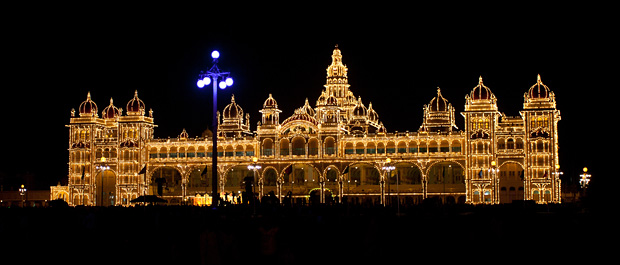
I made a short day-trip to Mysore to witness the Dasara celebrations. But at a time when the government was grappling with the problems of survival and had other imperative things to look after, the festival had become a low-key activity. There were information kisoks where people disseminated old tourist brochures but did not know the festival schedules. The famed mud-wrestling had now moved on with times and had shifted to a synthetic turf. The exhibition was not yet open and the cultural activities were limited to the evening hours. Our day at Mysore was limited to exploring the palace, and I am glad it turned out so.
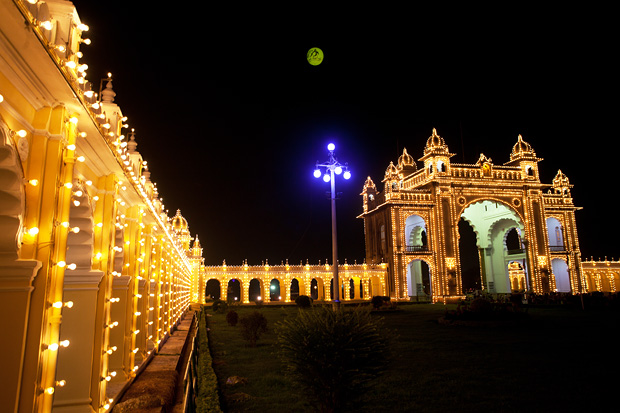
Most of my visits to Mysore in the past were on transit. I admired the quiet, wide lanes of the town as opposed to Bangalore’s congestion. I was jealous of its open spaces and the lakes teeming with birds. But it was just once that I stopped to see the sights, and even then, did not visit the palace. I made up for the loss on that day of Dasara. When the festival did not offer the expected excitement, it became a day dedicated to exploring the palace.
Even when it became obvious from outside that it is a grand edifice perhaps filled with luxury, the insides continued to impress me at every corner. The tall pillars painted in turquoise, the grand wedding hall three-stories high, the dolls of marble and wood on display, the golden throne, chairs of crystal and silver, an unbelievable work of tusks inlaid into wooden doors, gilded decorations in the private darbar hall, the grand pillars and marble floors of the public darbar, an array of canons in the courtyard, exquisite paintings of dasara procession make up only a small part of the impressive palace. The architects of the palace have not stopped until every corner of the palace is perfected and every room is decorated in the best possible way.
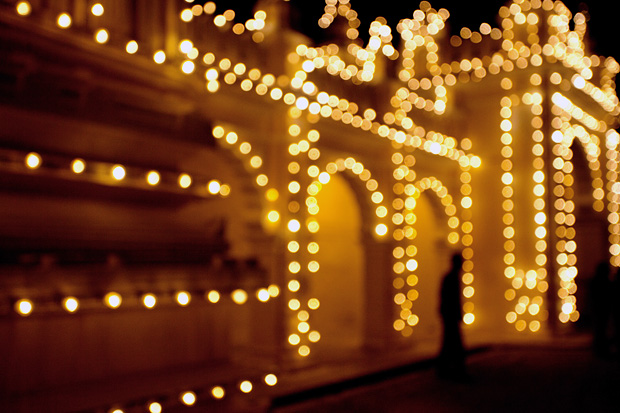
That evening when a cultural event was in progress in the palace premises, our eyes were focused on the edifice and its lighting. It looked like yet another beautiful structure in the evening hour as the floodlights focused on the walls. But the moment the decorative lights hugging every corner of the palace came alive, it was like a revelation of the maximum stretch of beauty. I admit, I haven’t seen anything else as grand and as beautiful yet.
See location map of Freedom Park at the end of this post.
Freedom Park is a large open space in the heart of Bangalore, at Sheshadri Road. This place once functioned as the ‘central jail.’ After the prison was shifted outside the city, the then government had the goodwill to convert it into a park instead of coming up with more buildings in the area.
The design of the park was chosen through a national level competition. A plaque installed in the park says more about the history of the prison and the establishment of the park:
The Central Jail
The first war of Indian Independence gave a new thrust to the freedom movement in India. Many Indians joined the movement and the British, to curb the movement, began sending more and more freedom fighters to prisons. As a result, the British needed more and more jails to accommodate the rising number of self sacrificing freedom fighters. The Bangalore Central Jail was constructed against this background in 1866. It occupied a site of approximately 21 acres. The Jail has housed many illustrious leaders who fought for the freedom of our nation and for restoration of democracy during the emergency regime post independence. The Jail compound included a watchtower in the center, barracks and other buildings like the hospital, workshops, etc.
Freedom Park
The design of the park was selected through a national level competition initiated by BBMP. Architect couple Soumitro Ghosh and Nisha Mathew Ghosh won the competition and the park has been developed based on their design on a budget of Rs.17.35 crores.
The main objective of the park is to create green cover and lung space in the heart of the city without diluting the historical significance of the location. As a result, a beautiful multi-use urban park with a state-of-the-art information corridor, cultural and leisure joints, children’s play areas, light and sound shows etc. has come up on the sprawling 15-acre area of the erstwhile central jail of Bangalore. A dedicated space for holding protests and rallies, on the lines of Hyde Park in London, was proposed on an area of 6 acres as a solution to the traffic concerns that protests and rallies in the city center trigger. The most beautiful aspect of the park is the vision of architects in creating volumes of space using light while providing all necessary amenities to the public.
Commissioner, BBMP
The park has plenty of open space with lush grass and a walk way along the park walls. Inside, the watch tower of the prison is the major landmark visible from nearly everywhere. The architects have kept the barracks unchanged except adding some finer touches. The prison cells too have been left unchanged, but the passage to the cells is kept locked and inaccessible. There is an amphitheater next to the barracks. A canteen is work in progress.
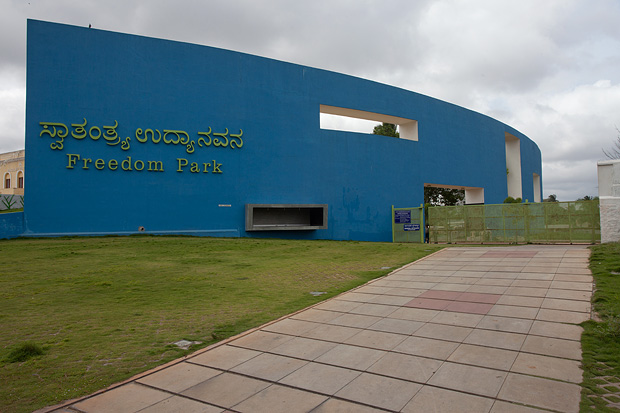
Entrance to Freedom Park
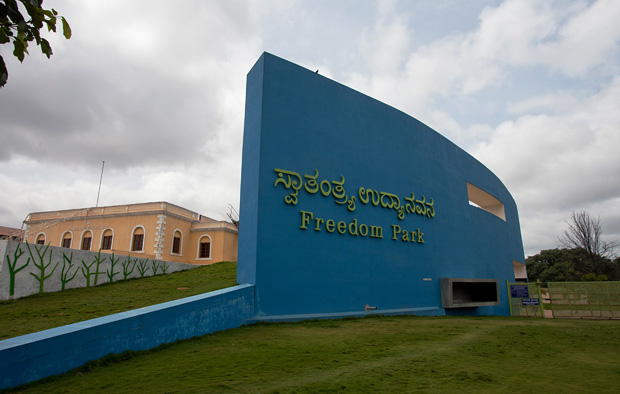
To the left of the entrance is the old central jail building.
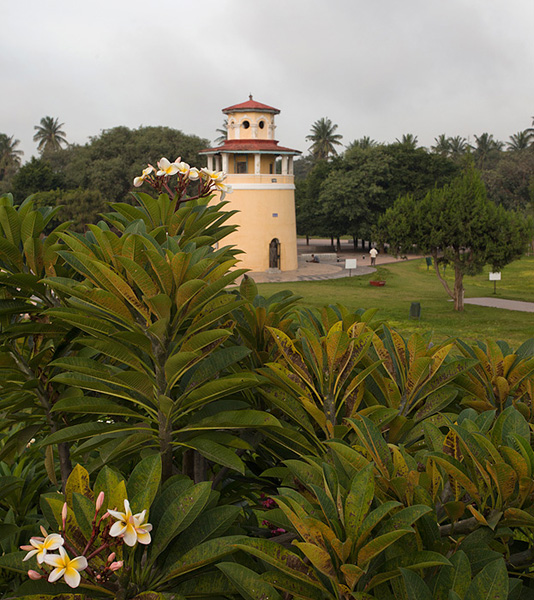
The watch tower at the center of the park
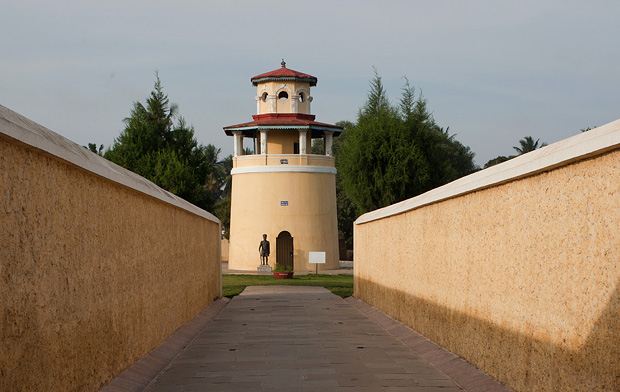
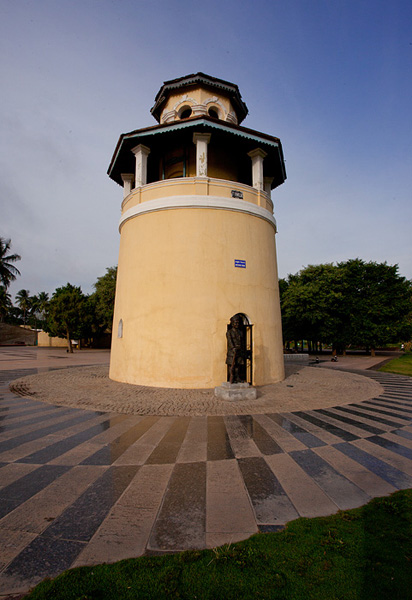
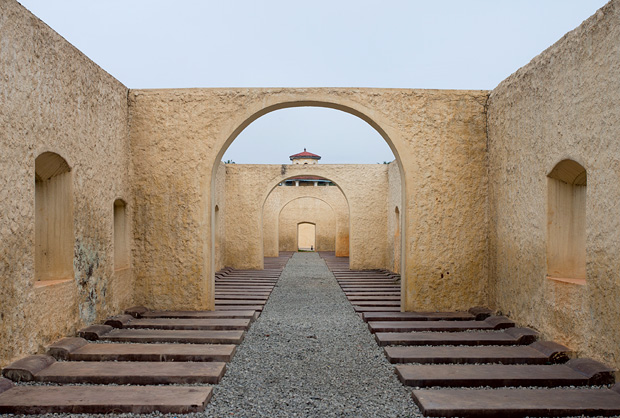
The barracks
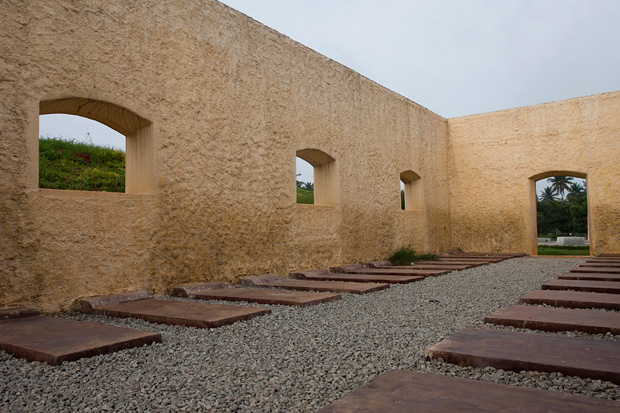
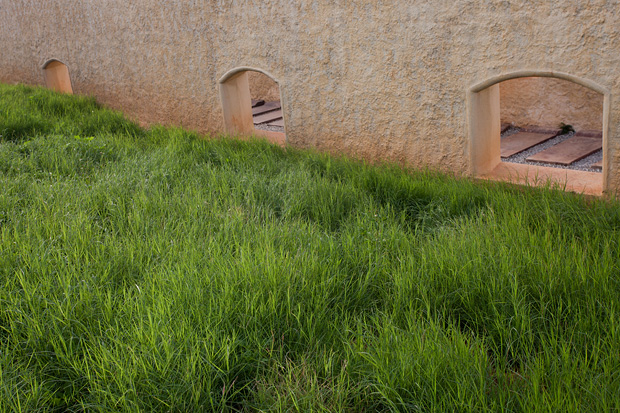

Insides of the park.
Location map of Freedom Park.
View Freedom Park, Bangalore in a larger map
Prints of all the images available. Request for prints.














